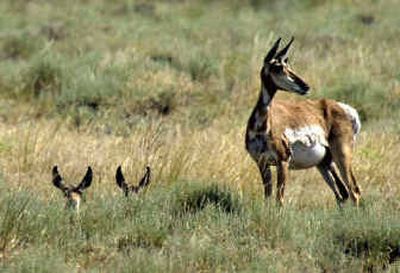Bison Range kills coyotes to protect pronghorns

MOIESE, Mont. — The U.S. Fish and Wildlife Service has shot 11 coyotes on the National Bison Range so far this year, in an effort to give newborn pronghorn antelope a better chance of survival.
Officials took the action after learning that coyotes killed every one of the pronghorn fawns born last season.
Wildlife biologists contend the loss of the fawns does not alone constitute a serious threat to the pronghorn population at the bison range, but the coyote killings are a necessary response to make sure this year’s fawns have a better chance.
“We don’t have a crisis,” said Lee Jones, a U.S. Fish and Wildlife Service biologist. “There hasn’t been a huge event or die-off that would result in our losing our genetics.”
Bill West, assistant manager for the bison range, said this year’s coyote killing is the largest predator control action of its kind in a decade at the refuge.
Up to 15 coyotes may be killed each year under the refuge’s coyote-management policy, although most years such aggressive coyote control is not needed to maintain a healthy pronghorn population, West said.
Coyotes living on the bison range serve as a natural population control for the antelope. But the resident coyotes often are joined by coyotes from neighboring rangeland in the Jocko and Mission valleys. Coyotes dig under the range’s 8-foot-high fence to gain access to the relatively easy pickings.
Disease, parasites and poor nutrition also can reduce antelope survival. Biologists said the overall health of the antelope herd has been poor in recent years. The adult population has fallen to 41 does and just seven bucks, less than half the population the bison range can accommodate comfortably, biologists said.
This spring, Jones is carefully monitoring body condition and population numbers of pronghorn females each week at Alexander Basin, a broad grassy range at the foot of Red Sleep Mountain on the northern boundary of the refuge. Fawns normally are born in May and June.
“We know we need to have as many (pronghorn fawns) as possible survive this spring,” Jones said.